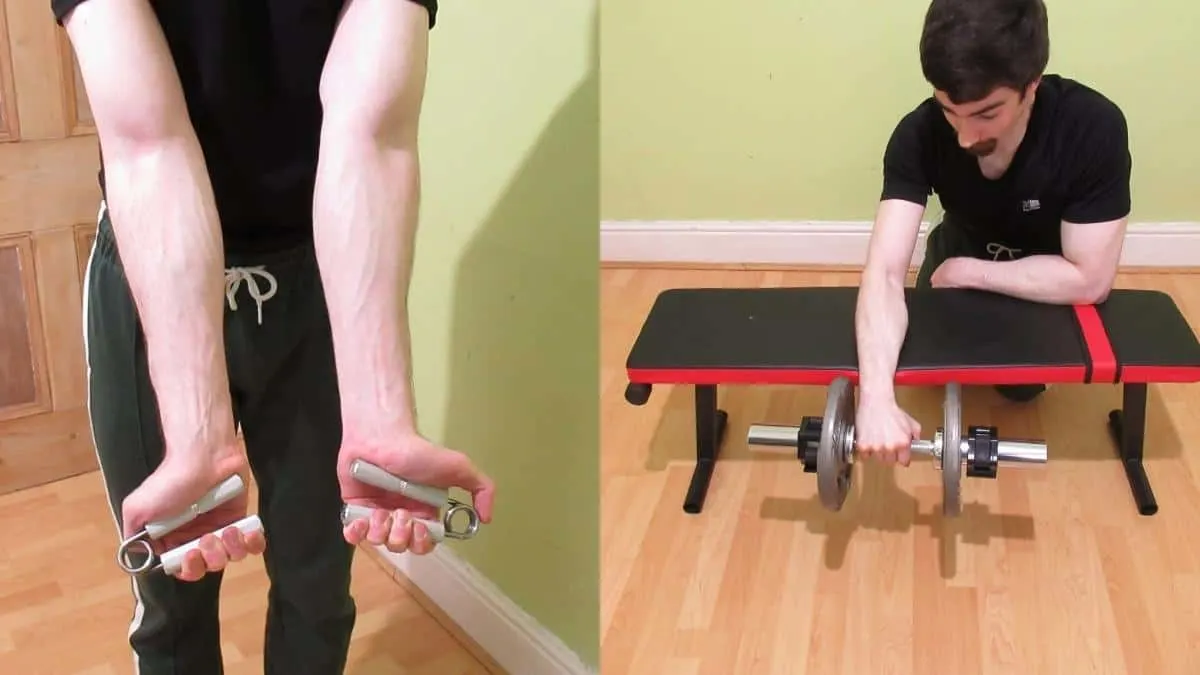The forearm consists of a complex group of bones and muscles. And while there are multiple options for treating forearm cramp, fractures, and forearm muscle strains, many people seem to forget all about rehabilitation.
And that’s a mistake.
If you don’t rehabilitate your forearms, they’ll be less resistant to simple everyday stressors. To combat this potential problem, I’ve created a rundown of the best forearm rehab exercises.
These drills focus specifically on dynamic movements to get you used to using your forearms again. However, if you have tight forearm muscles or are looking for stretches, then check out our dedicated guide on how to stretch your forearm for something more specific.
Best forearm rehabilitation exercises
You can do these forearm rehab exercises in any order. But I recommend starting with the weightless exercises (great for warming up) before moving onto the dumbbell-based drills.
1. Wrist extension
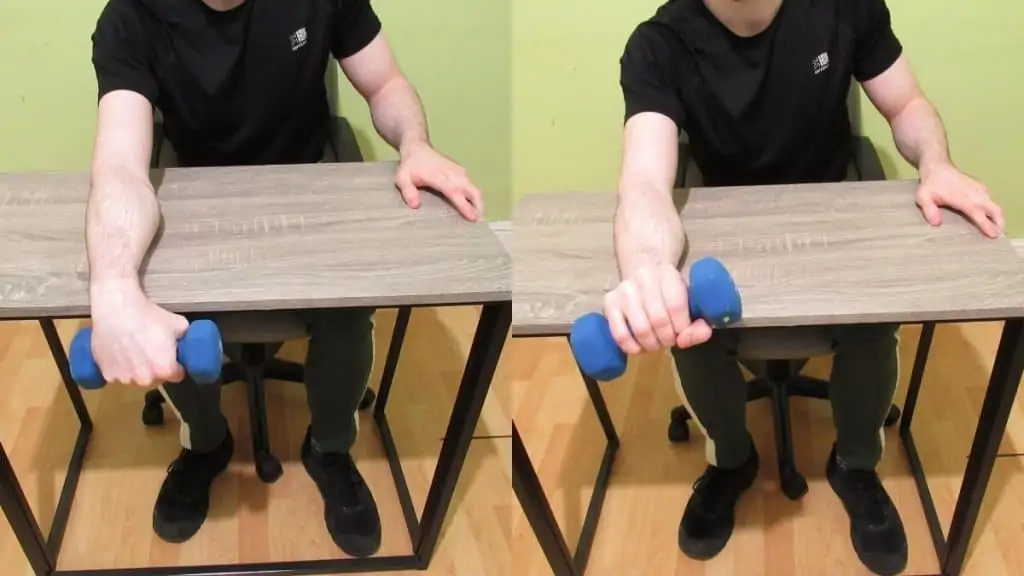
The wrist extension is a versatile exercise. All you need is a dumbbell (or a band) and a flat surface like your thigh or a table.
Better yet, you can customize the exercise to your level of fitness. For example, if you currently lack the forearm strength to do full reps, then you can lower the weight with one hand and then lift it back up with both.
For all of these tutorials, however, I’ll describe the drill from start to finish so that you know exactly what to do. But as I say, feel free to reduce the range of motion (ROM) until you build your strength up if you have forearm shin splints or similar conditions that might make you temporarily weaker.
- Hold a light dumbbell in one hand while kneeling over a weight bench or while sat upright in a chair.
- Place the underside of your forearm on a flat surface like a bench, table, or desk.
- Let your “dumbbell hand” hang off the edge.
- Bend your wrist towards the floor, and descend until you feel a good forearm stretch.
- Come back up by extending your wrist (i.e., by moving the dumbbell upwards).
- Bring the dumbbell past where your hand and forearm are level for the best contraction. This is one rep.
- Repeat for 2-3 sets of 10-12 reps, and always control the weight.
2. Wrist flexion
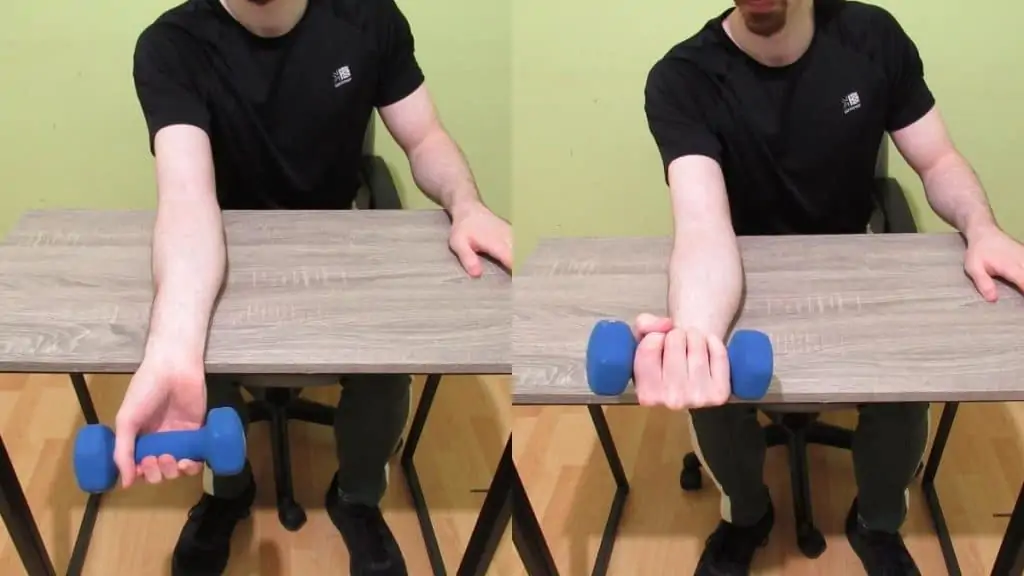
The reader who paid attention in their high school biology classes may realize that wrist flexion is the opposite of wrist extension.
As such, you can perform these exercises in succession. However, since there’s a fair bit of crossover, I like to take a 30-60 second rest between working my extensors and training my flexors so that the muscle burn doesn’t become too intense.
- Hold a moderately light dumbbell in one hand and sit upright in a chair or kneel over a gym bench.
- Rest the top of your forearm on a flat, stable surface, and let your hand hang off the edge.
- Bend your wrist and lower the dumbbell until you feel a deep yet comfortable stretch in the underside of your forearm.
- Bring the weight back up until your hand is slightly higher than your forearm.
- Squeeze your forearm flexor and then repeat for 2-3 sets of 10-12 reps, and don’t forget your other arm!
3. Stress ball squeeze
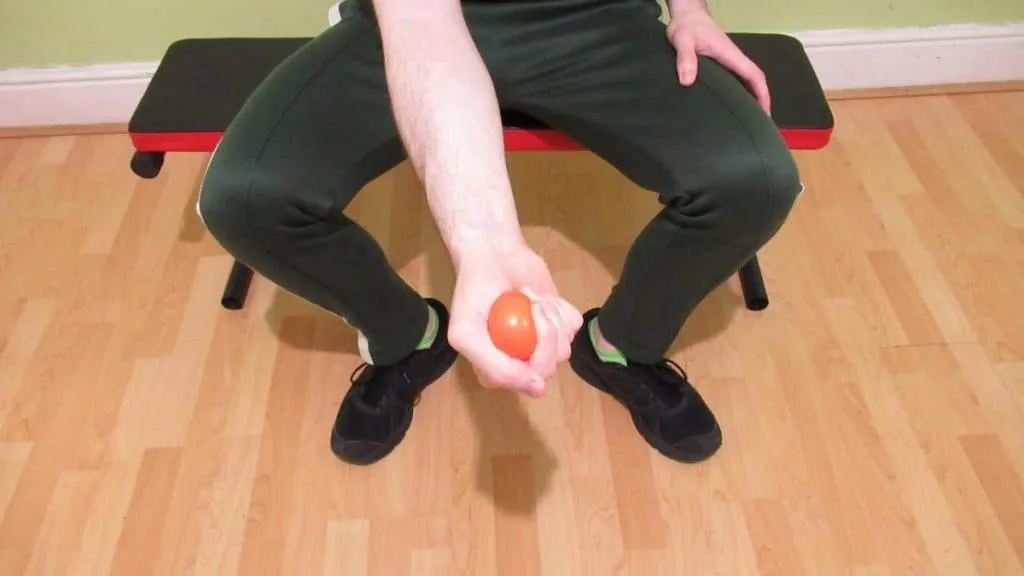
Squeezing a stress ball might seem like an insult to anyone who’s used to throwing weights around in the gym. But appearances are deceiving. Stress ball squeezes are one of the best forearm fracture rehabilitation exercises because they work your crucial hand and gripping muscles with a surprisingly decent amount of resistance.
Strengthening these key hand muscles may also help to reduce any pain in your wrist and forearm when gripping, which is something that numerous individuals struggle with.
- Hold a stress ball in the palm of your hand while stood up or sat upright in a chair.
- Squeeze the ball by moving your fingers towards your palm and vice versa.
- Repeat this motion 20-30 times in total. This is one set. Do around 2 sets for each hand or more if recommended by your physio.
Read more: forearm pain when typing │forearm pain because of gaming
4. Hand grip squeeze
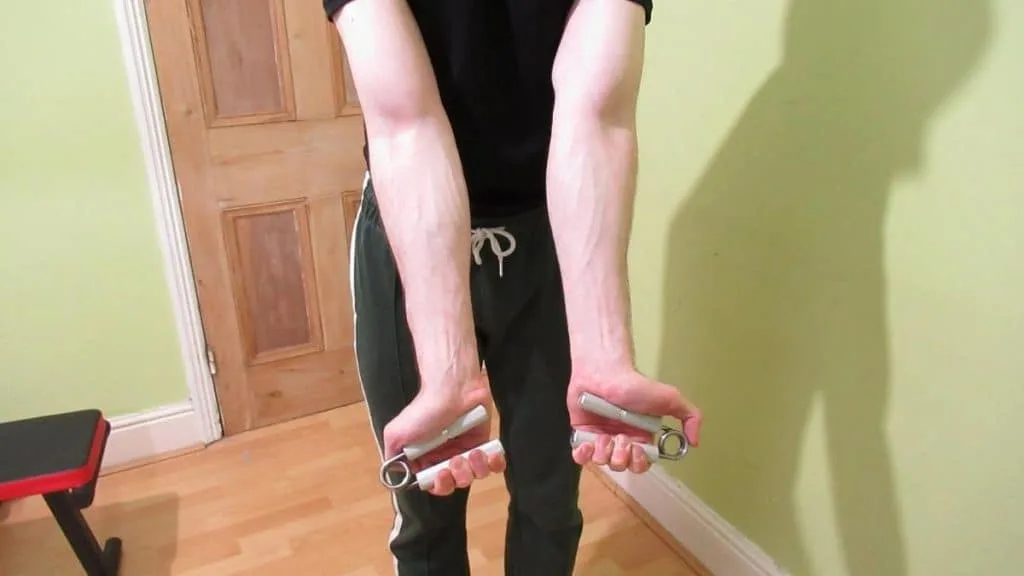
If stress ball squeezes have become too easy, then it’s time to crank out the hand gripper to build some strength. The great thing about these devices, which aren’t all that expensive these days, is that you can use them absolutely anywhere.
Just make sure to get one that’s adjustable so that you can start light and then progress once you build up your strength.
- Hold your hand grip trainer between your fingers and the palm of your hand.
- Squeeze the ends of the gripper until they both touch. Do this by moving your palm and fingers towards each other.
- Hold the contraction for a split second and then release the ends of the gripper under control, allowing your hand muscles to stretch out in the process.
- Repeat for 8-12 reps and do 2-3 sets.
5. Pronation/supination
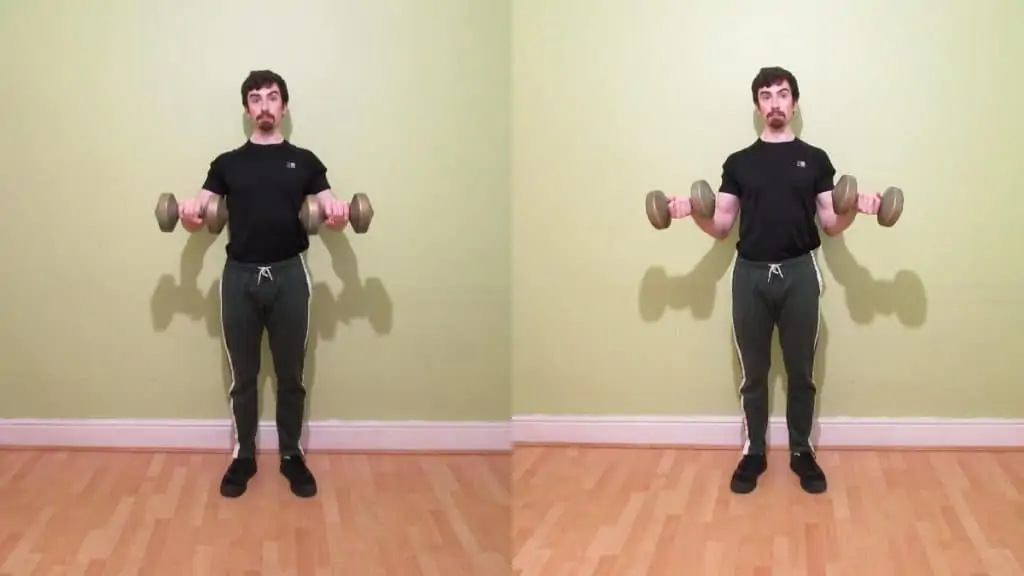
Most people who’re concerned with building an “aesthetic” physique would skip over this rehab drill. And that’s a shame because pronations/supinations are one of the top forearm rehabilitation exercises for building functional dexterity.
The fact that it’s a light exercise is great if your forearm hurts when lifting heavy weights.
- Sit upright in a chair and then place your hands—palms down—out in front of you.
- Slowly rotate your palms from a pronated (palms down) position to a supinated (palms up) position. Do this by moving just your wrists. Keep your shoulders still.
- Rotate your palms back to their original position, once again focusing on using your wrists to complete the movement.
- Repeat for 2-4 sets of 10-20 reps.
See also: forearm pain from pull ups │forearm pain from bicep curls │forearm trigger points
6. Farmer’s walk
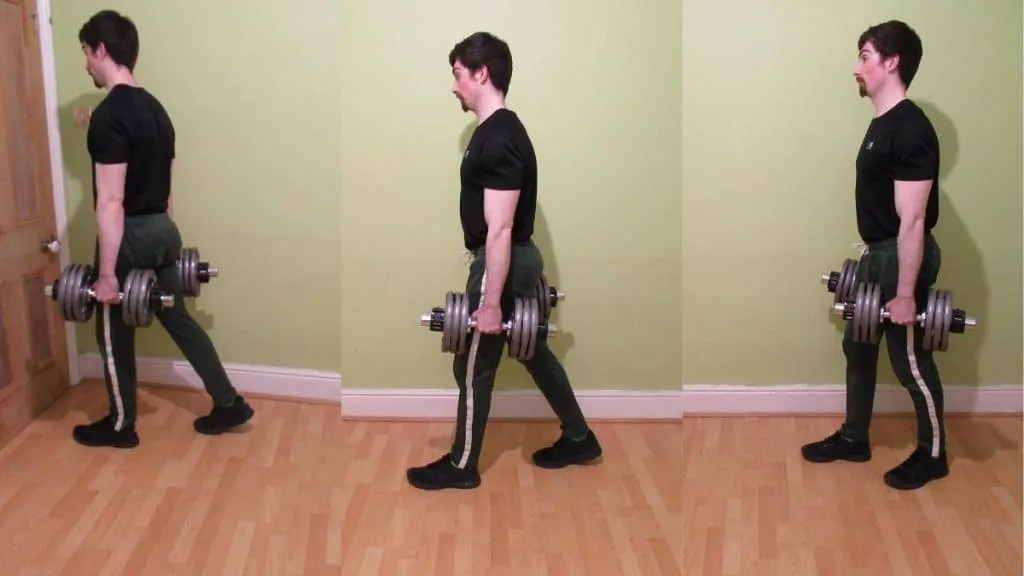
Weight lifters traditionally perform farmer’s walks with heavy weights to build up their grip strength. However, you can do them with lighter weights and still get the same benefits. After all, building functional grip strength that you can use in everyday life and developing superhuman grip strength for powerlifting competitions are two very different goals.
- Hold a pair of dumbbells by your sides with a neutral hand position.
- Walk with the dumbbells for 5-10 seconds in one direction (best done at a gym), and then walk back. Repeat this 2-3 times.
- Alternatively, stand still with the dumbbells in your hands for 15-30 seconds.
- Aim to hold the dumbbells in the palms of your hand rather than with your fingers. Of course, this will be significantly harder to do once your forearms fatigue.
How important are forearm rehab exercises?
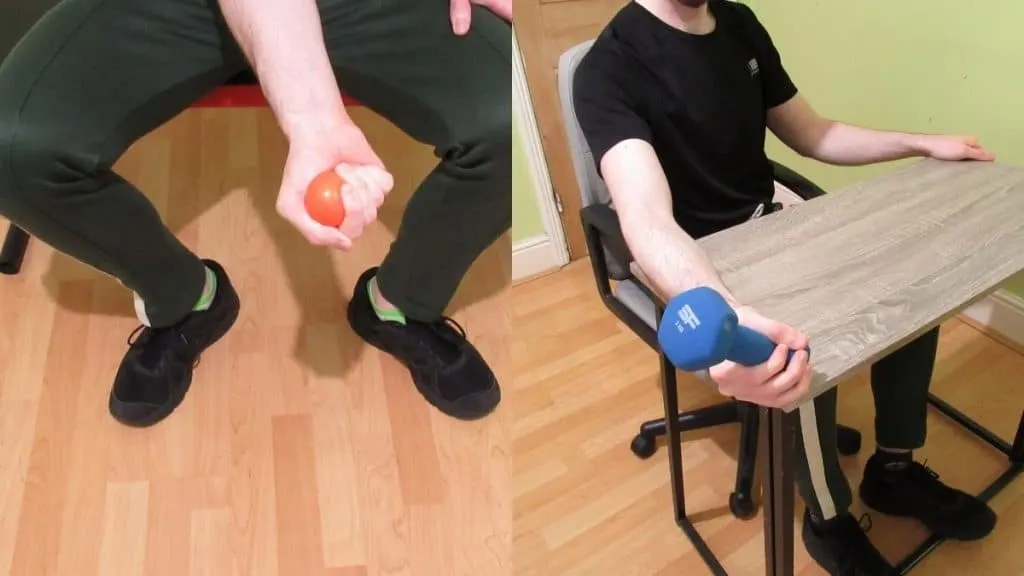
Forearm rehab exercises help to build strength in one of the most crucial body parts. Without functioning lower arms, performing everyday tasks would simply be impossible. That’s why rehab should be part of any recovery protocol. [1]
And the great thing about these forearm rehabilitation exercises is that you can do them with light weights and without going to the gym.
Ask your physiotherapist how much weight to use if you’re unsure. I usually recommend starting with the lightest weight possible and then building up from there.
Not only will these drills build strength, but they’ll also build dexterity in your hands, which most gym goers would never think about.
If your physio doesn’t recommend rehab at this stage, then you can also wear a forearm protection device to give your arm the rest that it needs to recover.
Read more: brachioradialis pain after lifting │forearm pain from fibromyalgia
The verdict on forearm rehabilitation exercises
Performing forearm rehabilitation exercises isn’t about lifting the most weight possible or using fancy equipment. [2] We’ll leave that for the powerlifters. These drills are designed to build confidence, dexterity in your hands, and strength in your forearms.
Ultimately, these forearm rehab exercises will help you to regain (and perhaps even exceed) the strength that you might have lost due to a fracture, sprain, or other injuries.
References
- Rehabilitation. (n.d.). Medline Plus. https://medlineplus.gov/rehabilitation.html
- Rehabilitation. (2020, October 26). World Health Organization. https://www.who.int/news-room/fact-sheets/detail/rehabilitation

